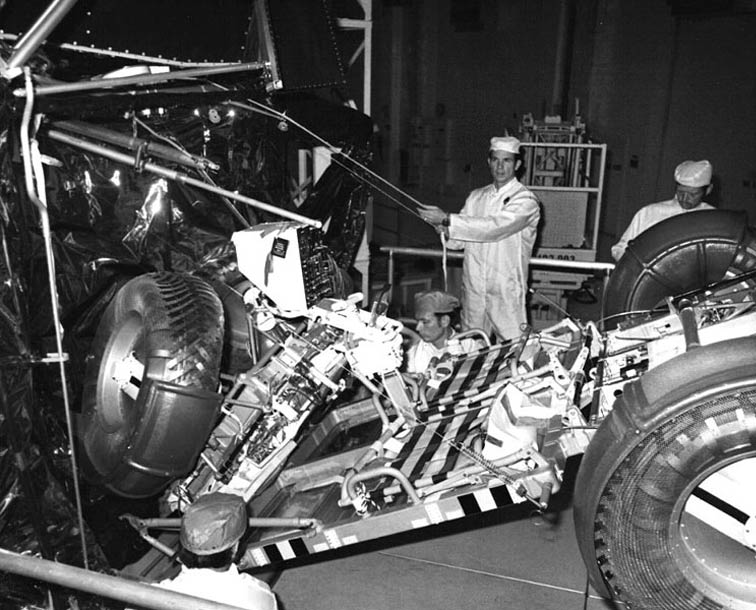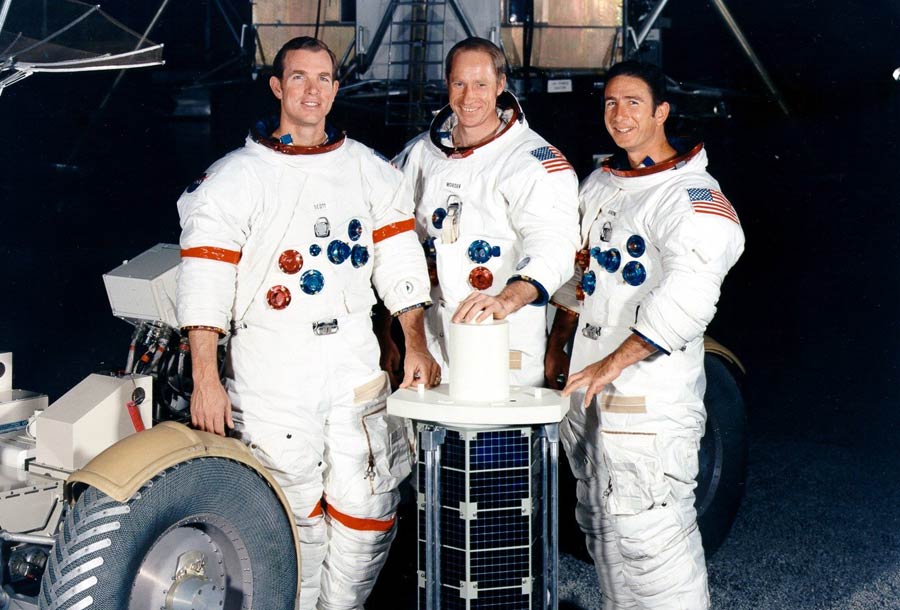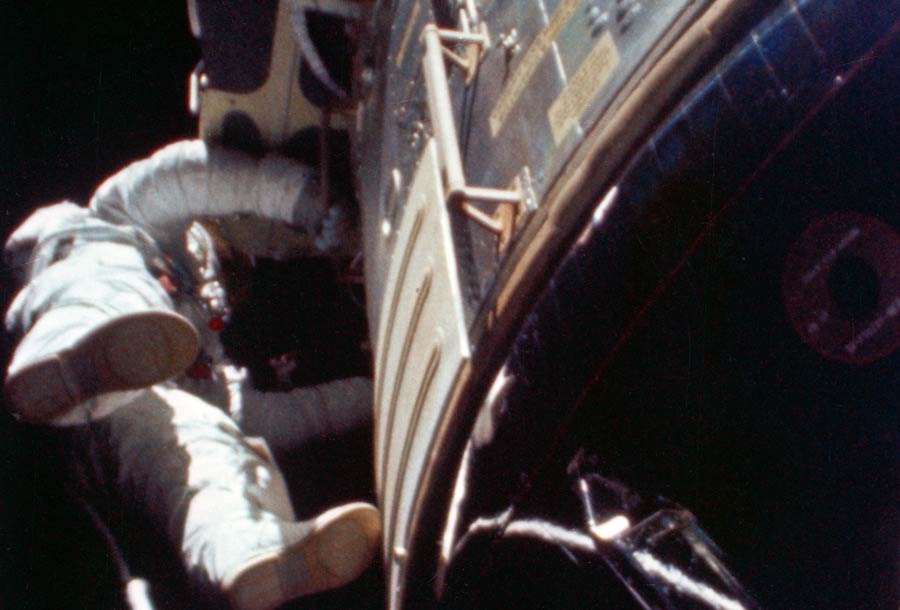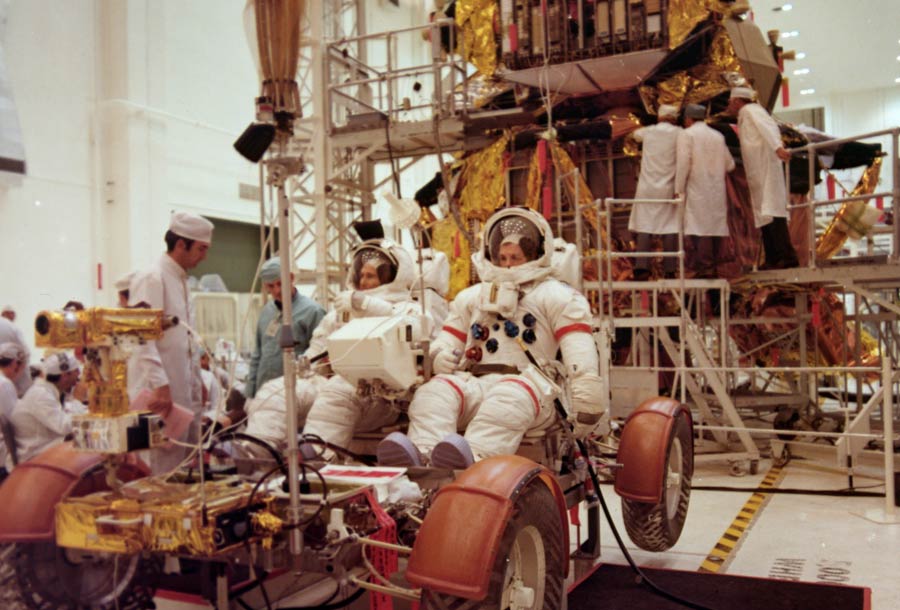Fifty years ago on July 26, 1971, Apollo 15 Commander David R. Scott, Lunar Module Pilot James B. Irwin, and Command Module Pilot Alfred M. Worden launched from Kennedy Space Center Launch Complex 39A and headed straight for the Moon.
Apollo 15 was the fourth mission to put humans on the lunar surface, this time, exploring the Hadley-Apennine region of the Moon. Three mission objectives of Apollo 15 included evaluating new equipment, conducting lunar surface experiments, and conducting lunar orbit experiments and photographic tasks.
Among the tasks required to achieve these mission objectives were deploying the first Lunar Roving Vehicle (LRV), demonstrating a hammer and feather drop, launching the first subsatellite into lunar orbit, and the first deep space Extravehicular Activities (EVA), or spacewalk.
LUNAR ROVING VEHICLE

The LRV was an electric vehicle produced to traverse the lunar surface in a low-gravity vacuum. It was an important tool for the Apollo missions, as it allowed astronauts to travel further and explore more of the lunar surface through EVAs. Apollo 15 was the LRV’s debut mission, with new LRVs used on the last two crewed missions to the Moon, Apollo 16 and Apollo 17. Scott and Irwin covered a total of 17.3 miles/27.8 kilometers over the course of three days and three EVAs, clocking just over three hours of driving time.
The vehicle, weighing more than 460 pounds/208.7 kilograms, could hold a payload of 1,080 pounds/ 489.9 kilograms on the Moon. To ensure the LRV was compact for transport, it was designed with a three-part chassis, and hinged so the body and tires could be folded up. The LRV fit snuggly into Lunar Module Falcon’s quad 1 bay, ready for Apollo 15 astronauts to pull on various tethers to deploy it on the lunar surface.
In the above video, Scott and Irwin work to deploy the LRV from Lunar Module 10 (LM 10). The originally selected LM for this mission was LM 9, which is on display at Kennedy Space Center Visitor Complex’s Apollo/Saturn V Center. When NASA decided to equip Apollo 15 and the following missions with LRVs, a new LM was created with the capacity to stow the vehicles.
HAMMER-FEATHER
At the end of the Scott and Irwin’s third and final EVA, Scott performed a live demonstration of Italian scientist Galileo Galilei’s 400-year-old theory. The theory states that all objects released together fall at the same velocity regardless of mass.
On Earth, if you were to drop a feather and a hammer simultaneously from the same height, the hammer would hit the ground first while the feather would slowly and gently descend to the ground. This is because of the air that makes up Earth’s atmosphere causing air resistance, or atmospheric drag. On the Moon, there is no atmosphere and therefore no drag, creating the perfect environment to demonstrate Galileo’s well-established theory. A theory in which its validity was crucial to the safe return of the crew to Earth.
SUBSATELLITE
The Particles and Fields Subsatellite’s purpose was to investigate the particles in space surrounding the Moon, the influence of the Moon’s magnetic field on the Earth’s magnetic field, the Moon’s mass, and more.

On the 74th revolution around the Moon of Command and Service Module (CSM) Endeavor, Scott, Worden, and Irwin launched the subsatellite from the Scientific Instrument Module (SIM) bay of the CSM. Then, the crew began their homeward journey.
The subsatellite confirmed the previously recorded findings that, though the Earth’s strong magnetic field deflects solar winds, the Moon serves as an obstruction to the solar winds because of its weak magnetic field.
DEEP SPACE EVA

On their way home, the crew achieved another first for the space program. Worden accomplished the first ever deep space EVA approximately 197,000 nautical miles from Earth. Outside the spacecraft, Worden made his way from the Command Module (CM) to the Service Module (SM), collected film cassettes from the SIM bay, and returned to the CM in just 18 minutes.
A RECORD-BREAKING MISSION
Apollo 15 was a record-breaking mission:
- Heaviest payload launched to lunar orbit, approximately 107,000 pounds
- Maximum radial distance traveled from the spacecraft on the Moon of about 17.5 miles
- Most lunar surface EVAs, one a day for three days
- Longest total of duration for lunar surface EVAs clocking 18 hours, 37 minutes
- Longest time in lunar orbit at approximately 145 hours
- Longest crewed lunar mission at approximately 295 hours
- Longest Apollo mission clocking 295 hours
- First deep space and operational EVA


During your next visit to Kennedy Space Center Visitor Complex, be sure to visit the Apollo/Saturn V Center! relive the wonder and excitement of the Apollo era. This one-of-a-kind attraction celebrates the unprecedented achievement of putting humans on the Moon and the awe felt in that moment by all humankind.
LEARN MORE
BUY ADMISSION




